About Hon-On Shakuhachi
My shakuhachi were born out of a desire for a flute suitable for my own meditative practice and honkyoku playing that would not be "distracting" to play - i.e., it would not squeak inordinately or require the player to strain to bring certain notes up to pitch, but would be well-balanced, and tuned/crafted for an older aesthetic that values simplicity and depth.
Hon-on jinashi shakuhachi are made in the old, Edo-era (Komuso) style. This means that they emphasize tonal color over volume, and make use of the natural nuances of each individual piece of bamboo as much as possible. They are intended primarily for old-style honkyoku playing, and thus differ from modern shakuhachi (both ji-ari and ji-nashi) in several important ways:
Finger Holes
Modern shakuhachi, both jinashi and jiari, have their finger holes spaced according to the Western musical scale. This is a result of the mingling of Eastern and Western cultures during the Meiji era, when shakuhachi became secularized and as such came to be used as an ensemble instrument. This is great when playing shakuhachi with other musical instruments, but ancient shakuhachi music (honkyoku) was written for a slightly different finger hole arrangement. Edo-era and Myoan shakuhachi use calculations known as "Myoan wari" to determine finger hole placement. In each case, the finger holes on the front are all evenly spaced, and their size is uniform. In addition to a certain aesthetical pleasure, they also provide a tuning that is ideal for Honkyoku. You have to adapt yourself to the instrument, "tuning" each note with your breath and your posture as well as with your fingers as you play. ツ and レ are a tad flat, チ is a bit sharp, and ハ (リ)and イ are a bit flat. These "quirks" actually aid the playing of honkyoku pieces, which were composed on such shakuhachi.

Again, Edo-era Komuso shakuhachi (right) have much smaller finger holes, usually ranging from 8 to 10.5mm in diameter (as opposed to 11 or 12mm on modern shakuhachi), and are carved out so as to create an "air bubble" under each hole. This reduces the volume, but allows the air to play around inside the flute, making the tonal color much more interesting. It also makes "utsu" sounds like カラカラ "pop" in a very pleasing manner.
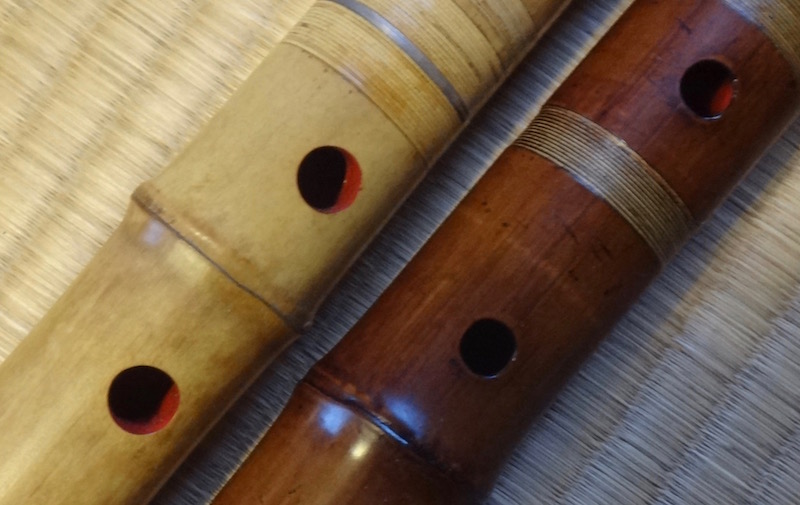
Nodes
Modern ji-ari (upper photo) and jinashi shakuhachi remove the nodes completely, and smooth out the bore of the shakuhachi. This produces more volume and a "sharper," more uniform sound, especially with ji-ari flutes. Edo-era jinashi flutes (lower photo) leave the nodes intact as much as possible, creating pressure chambers inside the shakuhachi, and a slight "glass bottle" effect, which lends a haunting, ethereal quality to the shakuhachi's sound.

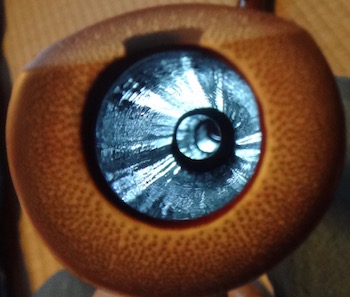
End Hole
For the same reason as above with the finger holes, the end hole on Edo shakuhachi (left) is much smaller than that of modern ji-ari (right) and jinashi shakuhachi. Less volume, more tonal color.
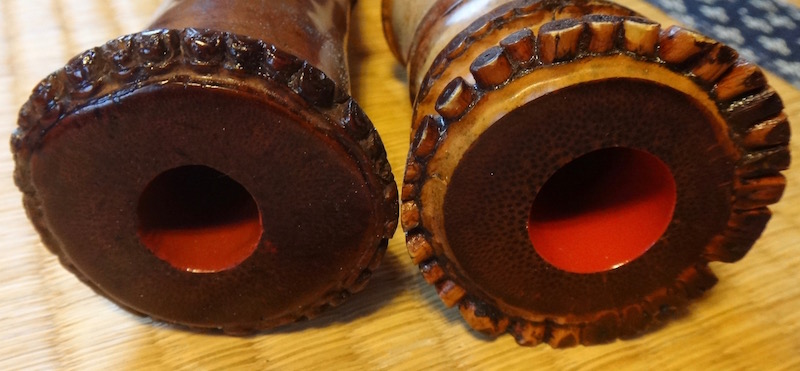
Ji
Around the beginning of the Meiji era, people began using shakuhachi as a musical instrument. As such, precise tuning and more volume became desirable. To achieve these, they put "ji", a mixture of ceramic powder and urushi (natural laquer) that creates a hard coating, building up the bore to a certain diameter, and making it almost mirror-smooth. This is great for ensemble music and stage performances, but for solo playing and meditation, you can do without it. Again, the invention of microphones allows even edo-era shakuhachi to be used in solo performances. Modern jinashi shakuhachi often use "ji" in a few locations to aid in tuning the instrument, but Edo-era jinashi shakuhachi don't use it on the bore. It is used, however, on the outside bindings during repairs.

Other features of Hon-On shakuhachi
Urushi
Urushi is a traditional, 100% natural Japanese laquer composed only of the sap of the urushi tree, which is of the same family as Poison Oak and Poison Sumac. As it cures, it changes chemically so as to no longer cause allergic reactions, but retains its antibacterial qualities, forming a hard, waterproof yet breathable coating. Urushi has been used in Japanese traditional arts for literally thousands of years, and was used on shakuhachi since the beginning. Without urushi on the inside, the bamboo tends to take on moisture, making the sound unstable, and inviting mold as well as cracks. Urushi serves to stabilize the sound, and discourages mold and cracking, making it a must if you want your shakuhachi to last.
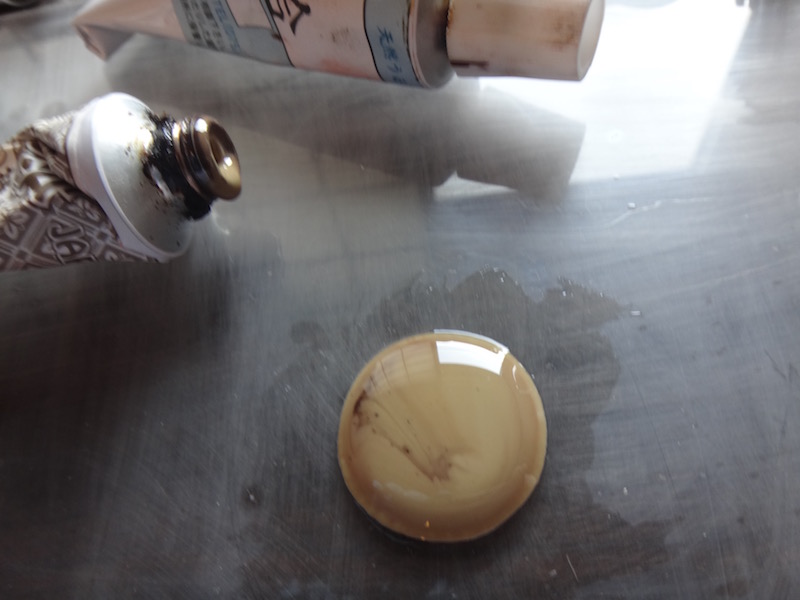
Utaguchi (Mouthpiece)
I make my mouthpieces in the Myoan style. Ancient shakuhachi had a variety of mouthpiece shapes, some more "square" and some more rounded. Mine are more rounded, just because I think it looks good, and plays well. Mouthpieces are traditionally made of Water Buffalo or Deer horn, or ivory; mine use Water Buffalo horn. I use only reclaimed horn, buying up decorative pieces that might have been thrown out otherwise. I can, however, use plastic or other materials for order-made shakuhachi. Early shakuhachi makers inserted mouthpieces of ivory or horn for at least two reasons: first, to protect the most delicate part of the shakuhachi from damage, as the thin bamboo at the mouthpiece can break or chip easily, and second, to protect it from mold. As the thin bamboo on the blowing edge is exposed to moisture, it tends to expand and contract, and if it takes on mold, the entire instrument is ruined. A good mouthpiece is important.
Again, the mouthpiece cut of Edo-era shakuhachi is very shallow compared to modern shakuhachi. This encourages deep, abdominal breathing rather than possibly strained "blowing." All that is required to make a sound is your natural breath.
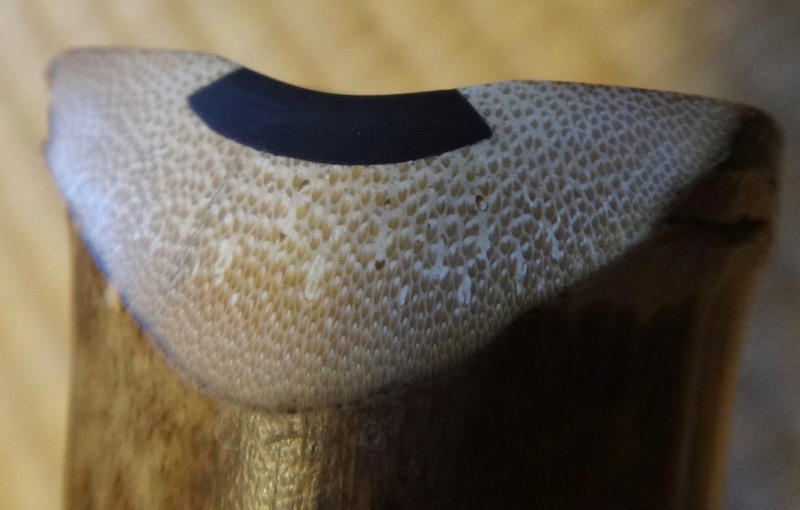
About the name "Hon-on"
Hon-on(本音)literally means "True Sound." The same characters can also be read in Japanese as "hon-ne," which carries two meanings - "true sound," and "true feelings."
Your true sound is you, as you are - your true self, and not the false self that you present to people in order to please them or gain their favor. In shakuhachi, "true sound" and "true feelings / true self" are inseparable. As one of my favorite teachers Barry Ho-un Weiss says, "A true sound is not always a beautiful sound."
To me, this embodies what the true Komuso of the Fuke Zen sect were practicing. Truth comes first. Just play as you are, and don't try to present your sound as "this" or "that." Let even your "undesirable" self show. Be yourself - this (rather than striving to turn yourself into something else) is what purifies and even changes you. Our true feelings are not always pleasant, and our true sound will not always be beautiful - but as we practice being true, a new beauty that we couldn't have produced even if we tried begins to emerge.
This is where my shakuhachi come from. They are made in an old, komuso style. Each stalk of bamboo has its own personality and intricacies, and each shakuhachi is different. You can't "blow" them to force them to do what you want; you breathe into them, and let them respond.
Business Stuff
Hon-on Shakuhachi is based in Japan and is owned and managed by my wife, Mutsumi Bellando. She also has a hand in other activities, such as playing music together, or designing and making our shakuhachi bags, hitoyogiri bags, music stand bags, etc. I'm lucky to have married someone who encourages me to use my strengths, and who is more concerned with incarnating God's personality in our lives than with having lots of fancy stuff.
"He who loves his wife loves himself." This is true. She is the root of my tree, the lily of my valley, my own heart. It seems that I can only love myself if I love her, and I can only treat her well if I care for my own heart. What a blessing.